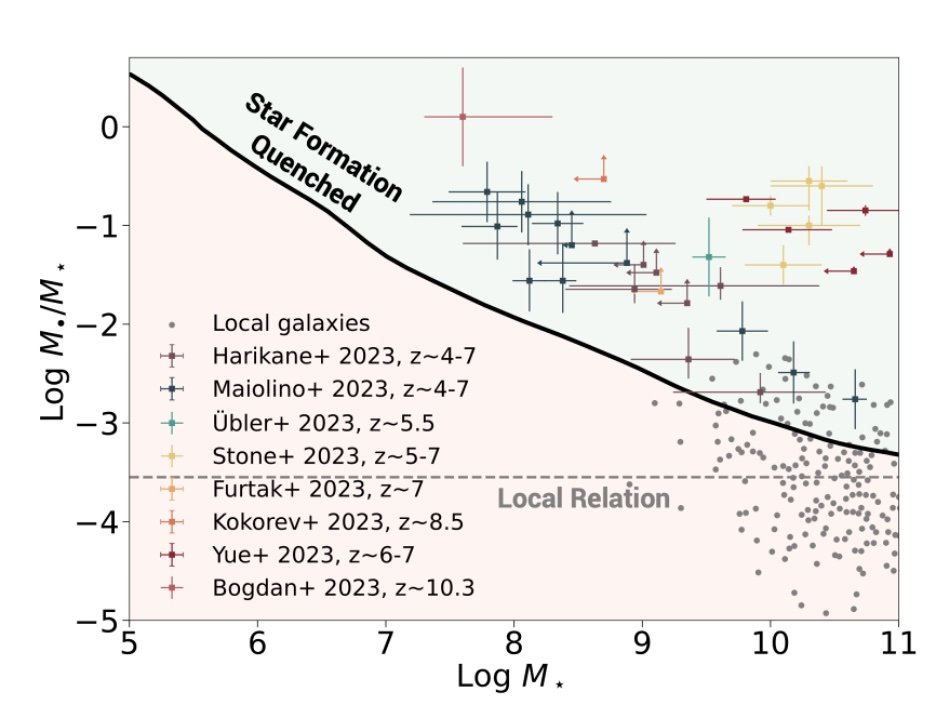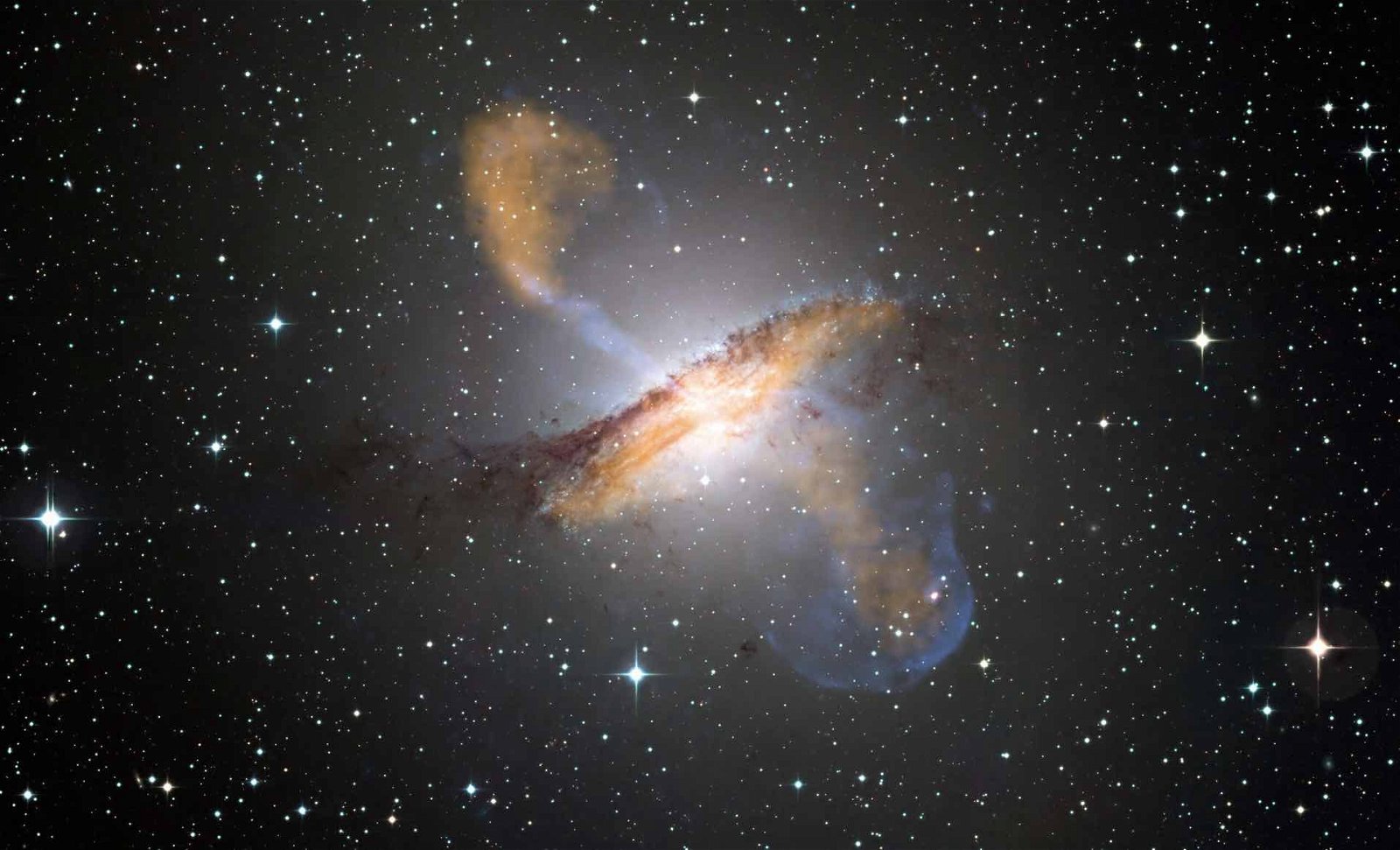Over the full cosmic history of the past 13.8 billion years after the Big Bang, supermassive black holes and stars produced roughly the same amount of energy output. Since both engines feed on gas, this suggests that their growth inside galaxies was self-regulated by their output.
Indeed, we know that massive stars generate powerful winds and explode as supernovae that can eject the surrounding gas from their host galaxy. Similarly, accreting black holes generate winds and radiation that can push out and heat surrounding gas. Both engines remove the gas that fuels them, just like babies that become energetic after eating too much and push the food off the table after gaining enough calories.
As a result of their energetic feedback, the mass in stars or in a supermassive black hole depends on the depth of the bowl that keeps their food. This gravitational potential well of their host galaxy can be gauged by the velocity dispersion of the stars trapped in it. Indeed, the present-day Universe exhibits tight correlations between the stellar velocity dispersion and the mass in stars or a supermassive black hole within the spheroid of their host galaxy.
But were the same relations in place for both engines within the first generation of galaxies in the Universe? We must keep in mind that stars can only form out of cold gas, tens of degrees above absolute zero, because at much higher temperatures the gas pressure does not allow fragmentation into small, self-gravitating clumps. The radiation emitted by an accreting black hole heats the surrounding gas to higher temperatures and suppresses star formation within its host galaxy for the duration of its growth period.
Interestingly, the growth time of supermassive black holes is comparable to the age of the early Universe at redshifts higher than 4. Given a universal seed mass, this growth period is only logarithmically dependent on the final black hole mass because of exponential growth to the saturation limit. This suggests that at late cosmological times – much later than a billion years after the Big Bang, episodes of black hole growth are transient, occupying a small fraction of the age of the Universe and allowing stars to form out of cold gas for most of the available time. Indeed, at late cosmic times, accreting black holes are observed as short-lived quasars. Consistently, bright quasars represent a small fraction of the galaxy population because they shine for a brief fraction of the available cosmic time, like transient explosions. At late cosmic times, quasars light up the dark Universe like fireworks in the night sky.
However, the situation was different in the infant Universe. Less than a billion years after the Big Bang, galaxies were rich in gas because they had not yet converted much of it into stars. This gas fueled black-hole growth over a period that occupied most of the short age of the infant Universe. The resulting heating of the surrounding gas must have suppressed star formation for most of the available time and led to the appearance of galaxies with over-massive black holes relative to the observed relation between stellar mass and black hole mass in the local Universe.
In a new paper that I just completed with the brilliant postdoctoral fellow, Fabio Pacucci, we showed that the latest data from the Webb telescope confirms this theoretical expectation. High-redshift galaxies are found to contain over-massive black holes relative to expectations from the local Universe. This confirms the expected suppression of star formation by the long duty cycle of the central black hole when the Universe was young.


And so, the cosmic race for consuming the gaseous food was won by black holes over stars in the first galaxies. For these young galactic parents, one baby – a central black hole – grew much more rapidly and denied food from the other baby – stars. However, stars were able to catch up and consume more gas after the first billion years, when quasar activity became sporadic and the galactic gas was able to cool to low temperatures.
As of today, supermassive black holes ended up containing just a tenth of a percent of the stellar mass in galactic spheroids. In other words, star formation consumed 99.9% of the gas that fueled both engines. Nevertheless, stars convert rest mass to radiation through nuclear fusion with an average efficiency that is a thousand times smaller than black holes, making the two engines equal contributors of energy to the self-regulating feedback within galaxies.
This was not expected in a decade-old textbook, titled “The First Galaxies in the Universe”. Like a kid, I get a kick from gaining new insights like this one into how the Universe works. Neil deGrasse Tyson noted that: “The Universe is under no obligation to make sense to you.” But as a practicing scientist, I get pleasure when it does make sense to me.
There are several reasons that life was less likely in the first billion years after the Big Bang. First, the chemistry of life as we know it requires elements like carbon and oxygen that were made in the interiors of stars and were rare at early times. Second, the high-energy radiation from quasars is harmful for life, suggesting that life on early planets was suppressed when quasars had a long duty cycle in early galaxies. Finally, the number of life-hosting planets must scale with the number of stars, for the same reason that the number of neighbors scales with the number of houses on a street.
It is therefore not surprising that we find ourselves in existence long after the first billion years since the Big Bang. We arrived late because the life of the party started late after the quasar fireworks ended. Happy new giga-year!
Avi Loeb is the head of the Galileo Project, founding director of Harvard University’s – Black Hole Initiative, director of the Institute for Theory and Computation at the Harvard-Smithsonian Center for Astrophysics, and the former chair of the astronomy department at Harvard University (2011-2020). He chairs the advisory board for the Breakthrough Starshot project, and is a former member of the President’s Council of Advisors onScience and Technology and a former chair of the Board on Physics and Astronomy of the National Academies. He is the bestselling author of “Extraterrestrial: The First Sign of Intelligent Life Beyond Earth” and a co-author of the textbook “Life in the Cosmos”, both published in 2021. His new book, titled “Interstellar”, was published in August 2023.

